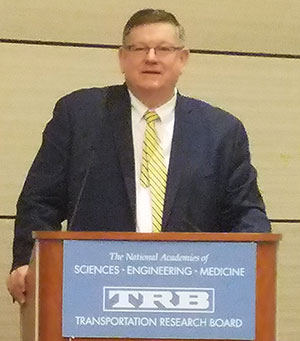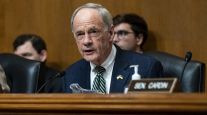Senior Reporter
FMCSA’s Top Priority in 2020: Reducing Large-Truck Fatalities

[Stay on top of transportation news: Get TTNews in your inbox.]
WASHINGTON — Federal Motor Carrier Safety Administration Acting Administrator Jim Mullen has tasked his entire agency with finding ways in 2020 to turn around an increase in large-truck fatalities over the past four years.
“When I assumed this role as acting administrator three months ago, the members of this panel asked me what are my top priorities,” Mullen told a group attending a session at the Transportation Research Board’s annual meeting Jan. 14. “That to me was a no-brainer. The top priority for me at this agency is to reverse that four-year trend increasing fatalities involved with large trucks and buses.”
In a “commercial motor vehicle safety landscape” briefing, Jack Van Steenburg, FMCSA’s chief safety officer, underscored Mullen’s concerns over the recent national trend of large-truck-involved fatalities.
Acting Administrator Jim Mullen and FMCSA's enforcement, policy, and research offices spoke today at the @NASEMTRB's annual meeting to highlight data and the importance of emerging technologies in roadway safety. pic.twitter.com/5Y2SBBroPX — FMCSA (@FMCSA) January 14, 2020
From 2017 to 2018, the number of large trucks in a fatal crash with a weight rating between 10,001 and 14,000 pounds increased 4.6%, while the number of trucks over 26,000 pounds increased 1.6% over the same period, Van Steenburg said. Likewise, he said the number of large-truck occupant fatalities increased to 885 in 2018 from 815 in 2016. In addition, more than 40% of large-truck drivers who were ejected in fatal crashes had failed to wear their seat belts.

Jack Van Steenburg by Eric Miller/Transport Topics
The top driver-related factors in large-truck fatal crashes were speeding, distraction and failure to yield right-of-way, he added.
“The first goal is to stop that upward trend,” Van Steenburg told the group of executives attending the TRB session. “For the next several months we at FMCSA are going to go out and talk with people. We’re going to listen to people. We want to tell them what we’re doing, ask how can we do it better, what can we do differently, and how can we do it differently to prevent these crashes from occurring.”
Van Steenburg added, “Do we need to do more inspections? Do we need to do more safety investigations? Do we need to do more enforcement? Do we need to do more outreach?”
Van Steenburg said agency leaders also plan to talk with state officials where large-truck-involved fatal crashes have recently declined.
“We always show you the top 10 states that have had crashes,” he said. “But in Pennsylvania we saw a 22% decrease in fatalities; Georgia, 16%; California, an 8% reduction.”
Joe DeLorenzo, FMCSA’s acting administrator for the Office of Enforcement and Compliance, told the group that enforcement of the agency’s electronic logging device requirement that became effective last month has been going well. So far, the agency is finding that just under 1% of truckers inspected did not have ELDs.
More From TRB
- FMCSA Seeks Comments for New Large-Truck Crash Causation Study
- State DOT Representatives Share Tips for Stretching Dollars
-
Metropolitan Leaders Discuss Congestion Pricing Challenges, Solutions
- Trucking Experts Tackle Parking in Panel
-
Information, Communication Technology Can Improve Port Efficiency, Experts Say
- Metropolitan Planners Encouraged to ‘Go Out in the Field’
In addition, he said the notion that ELDs are causing truckers to speed more often is not accurate. “We really haven’t seen any evidence of that,” he said.
However, DeLorenzo said that since the ELD rule was implemented, there have been new widely cited ELD violations ranging from no record-of-duty status to portable ELDs not mounted in a fixed position and visible to the driver.
However, some other violations have all but disappeared since the ELD rule went into effect, he said.
DeLorenzo said the agency has continued to look into updating its Compliance, Safety, Accountability Program’s safety measurement system with data obtained and analyzed using a so-called “Item Response Theory,” a complex method that is still not understood by many in the trucking industry.
He said in some areas, the system could do a better job of finding the trucking industry’s at-risk motor carriers.
The agency is not expected to finish an evaluation of the IRT model until later this year.
Want more news? Listen to today's daily briefing:




